Safety in Numbers
Union Pacific Cracks Down on Homeless Encampments
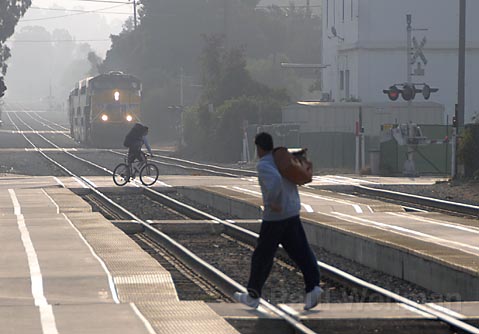
Since 1972, Operation Lifesaver has been a program run through the National Safety Council to educate people about the dangers posed by ignoring safety rules at railroad crossings. Aimed at reducing railroad crossing fatalities, the program effected a 43 percent reduction in its first year. For Union Pacific Railroad, the program is composed of public outreach and enforcement events every few months to educate the public on safe practices near railways, as well as the handing out tickets to show people that they mean business. On Thursday, June 26, Operation Lifesaver was focused on the 5.9 miles of track running through the City of Santa Barbara, with a special train running back and forth along the short stretch looking for violators of the railroad’s safety regulations. As the train-composed of two full-sized General Motors diesel-electric locomotives on either end of two passenger cars bristling with nearly twenty police officers from Union Pacific, the City of Santa Barbara, and the Santa Barbara County Sheriff’s Department-lumbered to and fro along the rails within the City limits, numerous violations were pointed out, and some apprehended.

Even as the train prepared to roll away from Santa Barbara’s downtown station, a convertible and a garbage truck could be seen rolling though State Street’s rail crossing while the gates were closing. “See that? That truck just barely made it through before the barricade arm came down,” said Steve Smith, one of Union Pacific’s safety officers. “That’s a violation,” he said again and again as people walked on the dirt path next to the track, drove cars after the barricades had begun to close, and scurried through the crossings long after the barriers were down. “We don’t want people to thinking that the trains only come at a certain time. There’s no schedule. You never know when a train will come. You never know whether the train will be a minute early or a minute late.” Indeed, Amtrak passenger trains are notorious for being off schedule, and according to Smith, freight trains have no schedule at all. They are run entirely by dispatchers. Last year, 161 accidents occurred in California between trains and people involved in illegal actions at railroad crossings-46 of those were fatalities. According to Operation Lifesaver’s statistics, trespassers on railroad property-those who cross or occupy railroad rights-of-way in areas not designated for passengers and other pedestrians-accounted for 82 of the state’s 2007 train-related deaths.
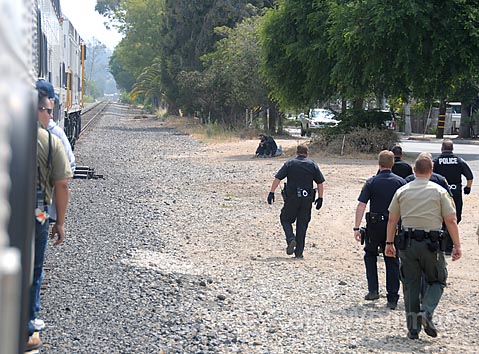
A majority of the trains running through Santa Barbara are passenger trains run by Amtrak, but about two or three trains per day are freight trains, which tend to be much longer. “A 5,000-foot train doesn’t stop for people if they’re in the way,” said Bob Whitaker, a conductor who began working for Union Pacific in 1971. “It needs 5,000 feet to stop.” One of the safety problems identified by railroad officials over the years has been the presence of homeless camps near the rails. Efforts launched by the City last year to clear thick vegetation were aimed at removing the eight to ten encampments which a City Public Works employee reported having found. A few camps were found on Thursday, and plenty of people were found walking along the dirt path that runs between the rails and the fence that marks the end of railroad property. From 9:30 a.m. until 11:30 a.m., officers had taken about a dozen people into custody for trespassing, with some in possession of illegal substances, and one man who was wanted for a parole violation. Although they were all handcuffed and taken aboard the train for transport, all of the detainees were released at the main station downtown-yellow citation slips in hand.
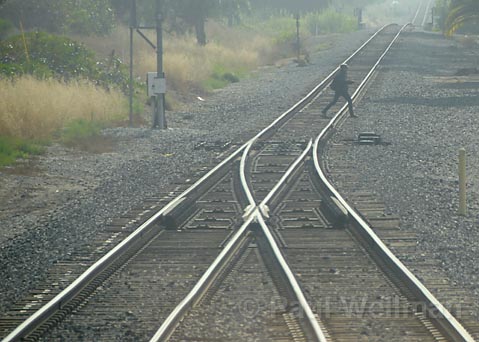
The striking feature about all of the people who received citations was that all of them were what the railroad terms “transient.” A group of reporters and law enforcement officers were present in the engine room of one of the locomotives as Smith pointed out a man on a mountain bike cutting through the right of way to get from State Street to an apartment complex near the station, and again as women in capri pants and summer blouses carried shopping bags down the same path. All of these people were spotted, but no example made. However, traveling down the track to the seamy underside of Santa Barbara that cannot be seen from the City’s palm-lined thoroughfares, City and railroad law enforcement officials hopped with ease from the passenger cars to slap on handcuffs and issue citations to the decidedly less cosmopolitan violators of the railroad’s property rights. Jorge Villaescusa, a Union Pacific police officer, said that because of increased train traffic, the need to keep the right of way clear is higher than ever. Smith said that safety is always the main concern, and that keeping the right of way clear is safer for both the people trespassing and for those aboard the train. Whittaker recalled a few fatalities during his long career as a conductor, and none of them sounded pretty. “The engineers have to see this stuff go on,” said Smith of the people who get a little too close to the speeding trains every year. “It’s a terrible thing to see someone die.” He also noted that Union Pacific prefers to have the right of way clear of debris, which he said can accumulate rapidly when a homeless encampment is nearby.
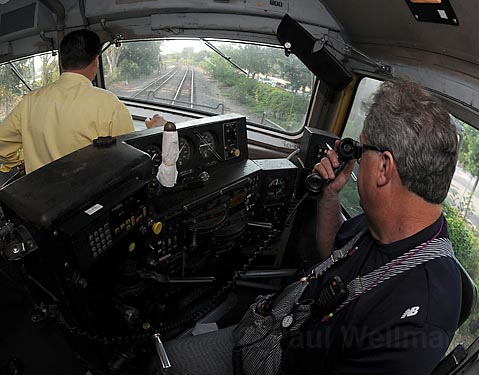
Ken Williams, a social services worker for Santa Barbara County who works with homeless people, opined that the railroad’s approach to clearing homeless people from the tracks is similar to the City’s attempts to keep them away from parks and beaches, and efforts by Caltrans to keep the sides of freeways clear of encampments. “They keep getting moved from point to point, but they come back because that’s where they live,” he said. “These band aid solutions are a huge waste of resources.” Williams also said that calling these people transients is inaccurate, as some of them have lived in Santa Barbara for decades. “They’re homeless, and they’re not going to just disappear. Camps elsewhere will get busier.” He also pointed out that the City’s main homeless shelter, Casa Esperanza, is only allowed to operate at half capacity for eight months out of the year. Its full contingent of 200 beds is only available from December to March.
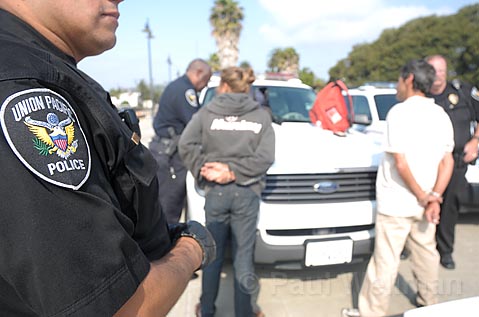
There appears to be a light at the end of the tunnel, though. City Council member Helene Schneider, co-chair of the leadership council which pushed Santa Barbara’s 10 Year Plan to End Chronic Homelessness, said crackdowns on homeless encampments happen because there are real threats to health and safety, but that different agencies are coordinating to treat the causes, rather than the symptoms of the problem. “Instead of [homeless] people going through this revolving door of emergency related services, they are getting stabilized,” she said, explaining that not only are peoples’ lives improved, but the long term costs are reduced as well. “There are some amazing success stories.” New York City, which started their 10 Year Plan several years ago, is already seeing marked results, with their population of chronically homeless people having fallen nearly 30 percent. “They’re actually closing homeless shelters in some cases, because there’s no longer a need for them.”



